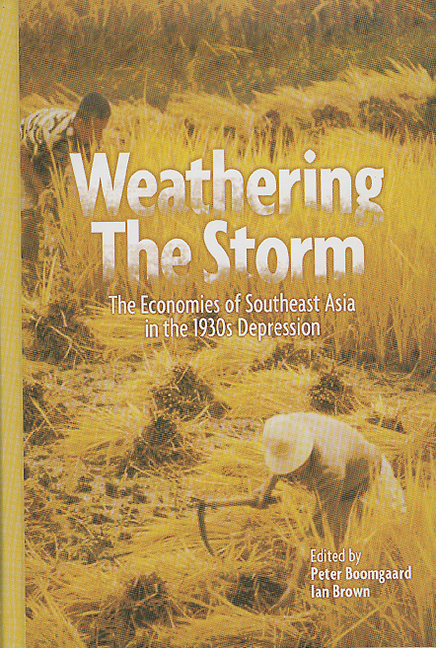Book contents
- Frontmatter
- Contents
- List of Tables
- List of Figures
- Acknowledgements
- List of Contributors
- 1 The Economies of Southeast Asia in the 1930s Depression: An Introduction
- PART I MATERIAL CONDITIONS
- PART II AGRICULTURAL STRATEGIES
- PART III TRADING COMMUNITIES
- 11 Hadhrami Arab Entrepreneurs in Indonesia and Malaysia: Facing the Challenge of the 1930s Recession
- PART IV THE STATE'S RESPONSE
- Index
11 - Hadhrami Arab Entrepreneurs in Indonesia and Malaysia: Facing the Challenge of the 1930s Recession
from PART III - TRADING COMMUNITIES
Published online by Cambridge University Press: 21 October 2015
- Frontmatter
- Contents
- List of Tables
- List of Figures
- Acknowledgements
- List of Contributors
- 1 The Economies of Southeast Asia in the 1930s Depression: An Introduction
- PART I MATERIAL CONDITIONS
- PART II AGRICULTURAL STRATEGIES
- PART III TRADING COMMUNITIES
- 11 Hadhrami Arab Entrepreneurs in Indonesia and Malaysia: Facing the Challenge of the 1930s Recession
- PART IV THE STATE'S RESPONSE
- Index
Summary
Arab entrepreneurs, on the defensive against Chinese competition in Southeast Asia since the 1880s, faced a new challenge in the depression of the 1930s. This chapter considers the Arab community in the Dutch East Indies and the Malay peninsula, which consisted overwhelmingly of Shafi'i Muslims from Hadhramaut in southern Arabia. Other groups of Hadhrami entrepreneurs were to be found in East Africa, the Red Sea, and South India. Small numbers of Hadhramis were established elsewhere in Southeast Asia, but little is known about these communities. As for Arab entrepreneurs in the Philippines, they were mostly Christians from Greater Syria.
The few indications on the position of Arabs in the economies of the Dutch East Indies and British Malaya underline both their wealth and their small numbers. There were only 4,949 Arabs enumerated in the 1931 census for the Malay peninsula and Brunei, but they were among the wealthiest communities. In 1936, they were reputedly the richest group in Singapore, in terms of ownership of assets per head. Dutch statistics rarely distinguished Arabs specifically, but the 1930 census showed that 71,355 ‘other Foreign Orientals’ were Arabs, compared to 30,018 Indians and some 14,000 others. In 1936, ‘other Foreign Orientals’ paying income tax had a higher income per head than either Chinese or ‘Natives’. Some 3,000 ‘other Foreign Oriental’ taxpayers earned about 9 million guilders in 1936, compared to 50 million for 27,000 ‘Natives’, 82 million for 37,000 Chinese, and 266 million for 65,000 ‘Europeans’. The last category is misleading, for it included all Japanese, plus various individuals who had acquired European status. A number of Arabs in the Dutch East Indies were reputed to be ‘multimillionaires’ at the end of the 1930s.
The problems of the 1930s are clear enough, but it is easy to forget the opportunities presented by the recession to this small but dynamic community.
- Type
- Chapter
- Information
- Weathering the StormThe Economies of Southeast Asia in the 1930s Depression, pp. 229 - 248Publisher: ISEAS–Yusof Ishak InstitutePrint publication year: 2001



